|
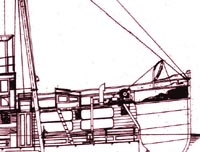
Click
for general arrangement plan
|
Specification
1901
The
specification for Vigilant was drawn up for the Commissioners
of His Majesty’s Customs by the Superintending Engineer
and Constructor of Shipping. His Majesty was of course Edward
VII and the Constructor of Shipping was a certain Mr H.Travis.
In the last decade of the 19th century the Customs had built
15 new steam driven vessels. This caused considerable problems
as no “technical establishment” had been formed.
An expert was urgently required. This is where Mr Travis came
in. He was seconded from the War Office.
|
|
|
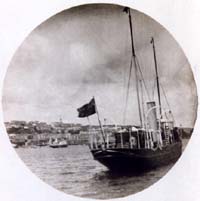
|
In
1901 the Inspector General of the Water Guard in consultation
with Mr Travis presented a report on the condition of the
then operating 35-year-old Vigilant. He recommended that
a new larger vessel should be built, not only capable of
patrolling outside the Thames Estuary but to cruise between
Dover and Yarmouth. A tender form was issued on 29th June
1901, which had to be delivered to Custom House, London
by 19th August 1901. It was for the supply of a Single Screw
Steam Cruiser.
Provision
was to be made for separate compartments not only for Captain,
Engineer and crew but for "any other officials".
Tendering companies were asked to quote for four engine
options, two Compound and two Triple Expansion. Each engine
type was to achieve a mean speed of either 10 or 11 knots.
|
|
|
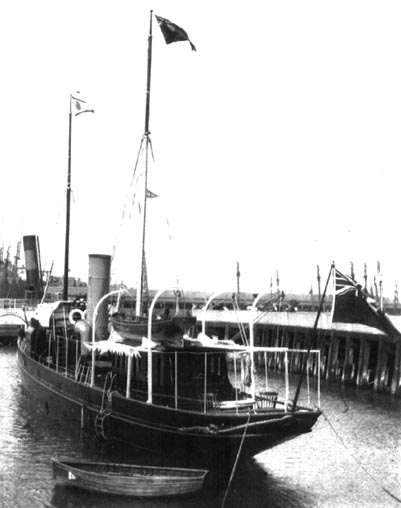
|
Built
1902
Tenders
were sought from various shipbuilders. The successful tender
was submitted by Messrs. Cox and Company of Falmouth. The
preferred engine was the triple expansion which would propel
the vessel at 11 knots and the price was to be £5390.
The rejected choices were priced as follows:
Compound, 10 knots, £5050
Compound, 11 knots, £5260
Triple Expansion, 10 knots, £5250.
It
is noted that Cox and Co. changed the completion date from
9 months after the date of acceptance to 12 months. A penalty
of £1 would apply for every day after the due date for
delivery.
|
|
|
Vigilant,
the seventh Customs Cruiser to bear that name, was to be 124
tons, 100 feet between perpendiculars, 16 feet moulded breadth
and a draught not to exceed 8 feet. The triple expansion engine
would have cylinders of 8.5, 13, and 21 inches diameter with
15 inch stroke and achieve an indicated horsepower of 200
and 210 revolutions per minute. The boiler was to have twin
furnaces, be of the return tube type, and have overall measurements
of 8 feet 6 inches in diameter and a length of 8 feet 3 inches.
Working
pressure would be 150 psi. In August 1902, just a year from
submitting the tender, Vigilant’s engineer gave her
a good report at her trials, and by the end of the month she
was accepted into the Customs Service.
|
|
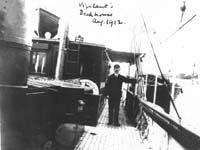
|
Vigilant
was based at Gravesend on the River Thames and her duties
were the control and clearance of ships using the Port of
London. After a year of routine work, Mr S.F.Parry, Deputy
Chairman of the Board of Customs, used Vigilant for an “inspection”
of every port from Gravesend to Penzance in Cornwall. This
happened to be in the holiday month of August, and not to
let a precedent go to waste, a similar cruise was organised
for the members of the Board every year thereafter.
There
is a panelled deckhouse on the after deck of Vigilant. It
is hard to allocate a purpose for this interesting feature
relating to the everyday work of the vessel.
|
|
|
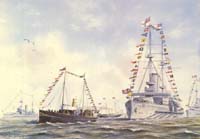
Picture:
Andrew Dandridge
|
In
1911, to celebrate the coronation of King George V, a Review
of the Fleet was held at Spithead. This is the stretch of
water between Portsmouth and the Isle of White. An Admiralty
order had been published that after 8 o’clock on the
morning of the review “no vessels, other than those
flying the White Ensign were allowed to approach or enter
the lines of warships”. Sir Laurence Guillemard, Chairman
of Customs and Excise, (amalgamated in 1909), informed the
Admiralty that Vigilant would proceed down the lines, stating
that the Department held a charter from King Charles II which
gave it greater powers than the Navy in home waters.
At
the appropriate time Vigilant, flying the Customs flags, and
in spite of heated objections, sailed down the lines of battleships
and anchored at their head. It is a salutary thought that
Vigilant is the only surviving vessel of the 1911 Review.
|
|
|
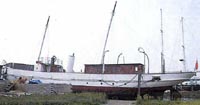

Photos:
Portcullis
|
In
1920 Vigilant was sold out of the Customs Service for £1850,
converted from steam to diesel and became a cruising yacht.
She was renamed Shalimar. During the Second World War she
was laid up. Being in American ownership she escaped requisition
and possible destruction. After the war she continued to cruise.
Renamed Eileen Siocht she was bought by a “delightful
lady” called Mrs. Nancy Kelly who is said to have had
a deep affection for the vessel and used her as a houseboat.
Originally
berthed at the Lady Bee Marina in Shoreham, she was later
moved to a mud berth on the other side of the River Adur.
In 1988 Nancy’s health caused her to start thinking
about a move ashore and she asked a local estate agent to
advertise Vigilant for sale.
|
|
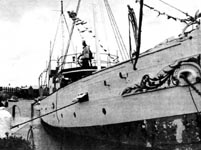
Photo:
Portcullis |
The
Vigilant Trust
The
estate agent contacted HM Customs and Excise to ask for
details of Vigilant’s early life and an ex-cutter
officer, now Head of Customs Maritime Branch, got to hear
about it. Following a visit to the vessel, he came away
enthused and immediately set about forming a charitable
trust to launch an appeal among his colleagues in Customs
and Excise. The asking price was £30,000 but when
Nancy became ill the Trust had not raised sufficient funds.
She
had to sell the vessel with the berth to a property developer,
who immediately asked £100,000 for Vigilant. During
the following year the price reduced in stages until the
original selling price was reached. By this time the Trust
had enough money and in March 1992 a deal was struck. Vigilant
became the property of the Vigilant Trust.
|
|
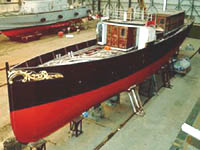
Photo:
Vosper Thorneycroft
|
Restoration
It
was not known at this stage, but restoration was not going
to be completed in one attempt. Vigilant was found to be
completely perforated at the waterline along her entire
length. An amazing effort and a gruelling schedule of work
by David Hewer and his colleagues achieved results. From
a vessel unable to float and stuck on a sandbank Vigilant
was patched and eventually towed to a slipway at shipbuilders
Vosper Thornycroft in Portchester.
Funds
were raised from several sources including the National
Heritage Memorial Fund, Portsmouth Naval Base Property Trust,
the Science Museum, the European Community, and from individual
members of the Customs Service who elected to contribute
via their payroll. Repairs to the hull were effected while
a Business Plan was prepared.
|
|
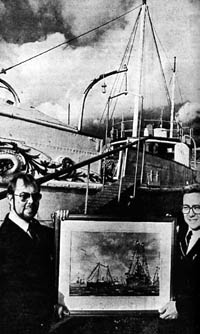
Photo:
Evening Argus
|
Rejected
Business Plan
It
is invariably the case that when funders offer money they
not only require “partnership funding” but also
a “business plan” to ensure continuing maintenance.
This was the case with Vigilant. An impressive plan was presented
with the co-operation of Portsmouth Council to make Vigilant
part of the Portsmouth tourist trail which would of course
include HMS Victory, Warrior, the Historic Dockyard etc. They
donated some money and a berth. The plan was rejected on the
grounds that the public would not be willing to pay extra
money because of the presence of Vigilant and she would therefore
be unable to support her own upkeep in the years that lay
ahead.
David
Hewer, Chairman of the Vigilant Trust, expressed his point
of view; “This is a familiar story to anyone who has
ever tried to obtain funding for an historic vessel and is,
in effect, a ‘catch 22’ situation which agrees
that the ship should be funded for restoration but denies
that very funding on the grounds of upkeep costs.” The
theory of the Medway Maritime Trust is that historic vessels
are rarely able in their own right to earn sufficient money
for their future maintenance. Another source of continuing
funds must be found.
|
|
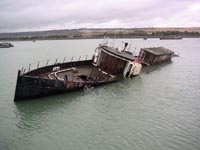
|
Harry
Pounds Shipbreakers
Owing
to the lack of space, Vospers then had to ask the Vigilant
Trust to remove the vessel from their yard. A deal was struck
with the nearby Harry Pound’s Shipbreakers yard in Portchester
to tow the hull there. Many of Vigilant’s fixtures and
fittings had been removed and placed in store. The deal with
Pound’s was that the hull could remain in their yard
free of charge while the Trust continued to try to raise the
needed funds, and only if they eventually failed would Pound’s
get it for scrap.
This situation went right to the wire when Pounds yard was
sold for redevelopment and the Trust was advised that all
potential scrap had to be disposed of. In the meantime Vigilant
had sunk at her moorings.
|
|
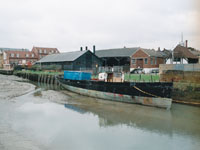
|
The
Medway Maritime Trust
The
Medway Maritime Trust came to Vigilant’s rescue with
one week to spare after being put in touch with the Vigilant
Trust by the Advisory Committee of National Historic Ships.
They offered a permanent berth for Vigilant in Faversham and
the Vigilant Trust were able to provide sufficient money to
fund the pumping out, preparations and towage required. This
was all organised by the Medway Maritime Trust and the assistance
that they have provided now offers Vigilant a future again.
Click
here
for an album of historical photographs (opens a new page)
Now
read about “The 2006 Rescue”.
|
|
I
History I The
Rescue I Recent News
I Links
I Fundraising
I Contact
Us I Main MMT Page
I
|